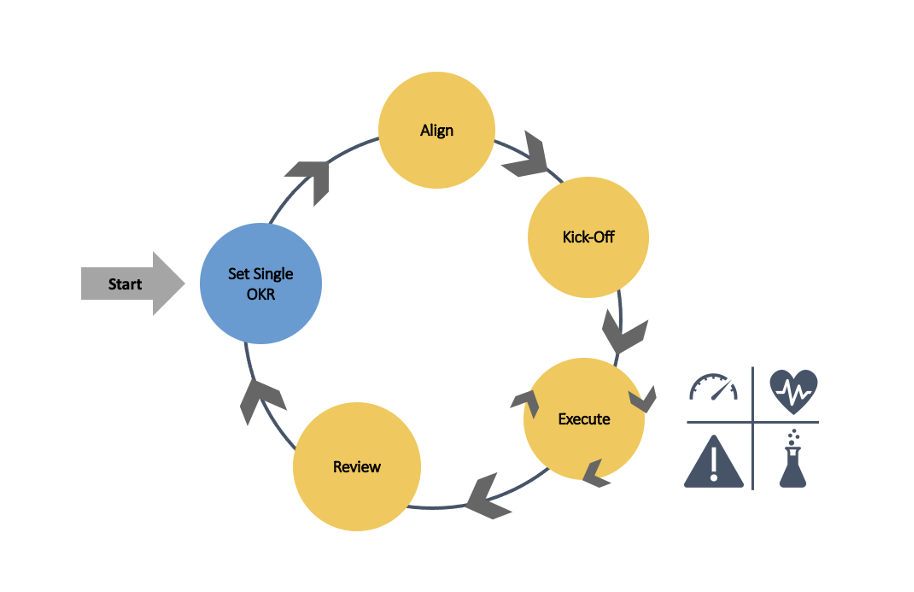Objectives and Key Results on their own have a tremendous ability for exponential growth – but when paired with Lean Thinking, it forms a powerhouse goal-setting framework, says Bart den Haak
Seated shoulder to shoulder with the senior directors, I once again found myself in the board room of a Fortune 500 company. ‘We need to work faster otherwise our competitors will beat us,’ one of the directors explained.
She continued: ‘If we don’t roll out these features in our system before this deadline, our customers will leave us’.
This was not the first time I’ve heard leaders say these or similar words. Of course, every company has deadlines, especially when their company is heavily dependent on seasonality. For example, an online retail store needs to have its products in-store and their IT systems ready before Black Friday. Or a bank’s digital systems need to be able to handle large volumes of mortgage repayments near the end of the year. That said, one could still argue how competitive these deadlines really are. Indeed, if a company misses them, their competitors will win new customers from these events. But any healthy company shouldn’t rely on such events to beat their competitors. They do so by having sound strategies in place that change customer and employee behaviour.
In fact, the focus on understanding customer behaviour and what their needs are will be the next great digital advantage for modern companies. When it comes to behavioural changes that impact the bottom line, there should be a methodology in place for measuring outcomes to know if progress is being made (or not).
There is a rather old management technique from the 1980s that fueled the growth of Intell (according to its former CEO Andrew Grove) and later Google, YouTube and Zynga to surpass their competitors at what appeared to be lightning speed. That tool is a special goal-setting framework called Objectives and Key Results – or OKRs for short.
You’ve likely heard of OKRs before. John Doerr’s 2018 book Measure What Matters really put it on the radar of business leaders as they became convinced by all the success stories of OKRs. Many leaders jumped on the so-called OKR bandwagon and rewrote current goals and KPIs as OKRs with the hopes of seeing similar results as those tech giants.
For many, the results were lackluster, and they abandoned OKRs altogether. OKRs only accelerated what was already present. I posit that what they were focusing on wasn’t an ambitious objective that would set them apart from their competitors, but rather an overload of average goals that quickly became overwhelming, too much red tape from management and maybe most importantly of all, no adjustment in mindset. I’ve seen it time and again, from large enterprises to small startups, that their goal setting is either absent or done with a cumbersome governance process around it.
Enter lean OKRs
OKRs on their own have a tremendous ability for exponential growth but when paired with Lean Thinking, it forms a powerhouse goal-setting framework. Lean is a philosophy based on the history of Japanese manufacturing techniques most commonly associated with the Toyota Kata. Lean hones in on creating excellent value for the customer by continuously pushing for improved business processes. This is done by adjusting and adapting human behaviour of both customers and employees alike.
The Lean mindset is what sets OKRs back on track as a tool for radical focus on a single, overarching, aspirational objective, one that all employees, regardless of department or function, understand and can get behind. Combining it with a lightweight governance model to set, track and achieve goals makes it like strategy execution on steroids.
Lean OKRs from the ground up
It starts by understanding the company strategy. Having a strategy is key, without it, OKRs simply won’t work. Then, leadership decides on which part of the strategy requires radical improvement (we call this Kaikaku in Lean), a goal that requires a change in human behaviour.
If you need to execute a very ambitious strategy, then behaviour change is part of that. Behaviour change is hard and takes time. Have you ever tried to change your own behaviour? Then imagine trying to change the behaviour of your team or a whole group of customers. It now becomes even harder. It requires focus, dedication, and accountability. At the same time, people have other stuff to do. ‘Business as usual’ is the biggest enemy of OKRs. It is why companies and teams can focus on only one OKR at a time.
For B2C SaaS companies to grow, they probably require a specific customer behaviour change. For example, to increase LTV, you need to make sure customers engage with your app more actively, or to move them from a freemium to a paid subscription. Your product teams can then set OKRs to focus on these challenges. This is the preferred model.
For other companies, especially enterprise companies, using OKRs can be challenging but worth the effort. Most of the time, teams are at arm’s length from the customers and their experience. Leaders in these companies can focus on an internal behaviour change. For example, using internal APIs, improving how leaders communicate strategy, greeting customers in a different way, proactively reducing manual tasks, seeking feedback from customers, and so on. In this instance, OKRs are used for organisational change and could, with some strategic thinking, help to build modern product teams.
Understanding the difference between the two is key. It doesn’t matter which company you’re in, OKRs are about solving hard problems. They are about changing human behaviour. They encourage cross-departmental team collaboration and alignment. Lean OKRs thrive on one single, overarching OKR that is decided upon by senior leaders evaluating the strategy and hashing it out on which Objective is the best one to proceed with. Based on the company-level OKR, teams and leaders then swarm around it and craft their own OKRs that will impact the company OKR. Leadership needs to bring the strategic context to their teams and collaborate with them on defining key results (measurable outcomes) and challenge them on their ambition level.
Install a lightweight governance process
Next, install a lightweight governance system (see Picture 1) that is easy for everybody to adopt and can be folded into existing ways of working (e.g. Scrum). That system is called the OKR Cycle; it’s like the operating system for achieving bold goals and seeing continuous behavioural changes.
The default Lean OKRs cycle is 90 days. It gives you and your teams enough time to make behaviour changes, test them out, experiment and build new habits. To stay accountable and measure progress, teams need to have weekly check-ins where they look at the latest data, define obstacles and run experiments to remove them.
An example of a good OKR:
Objective: Customers choose us over [competitor]
Key Results:
Increase the percentage of customers that prefer our product to the competitors in a blind test from 30% to 75%.
Increase the average order rating from 3.1 to 5.0.
The Lean OKR cycle – a lightweight governance process
Experimenting and adapting
In my practice, I like to use the term ‘scientific thinking’ to refer to a practice that will help your teams to move the needle on tough objectives. It is scientific thinking that will create innovation, by letting the people close to the technology solve hard problems. In the realm of Modern Product Development, teams and their managers use scientific thinking to explore and develop hypotheses to test. They have a whole arsenal of methods and techniques they can use to run small experiments and to do so fast. Multiple per week even. If you want to use OKRs, your product team needs to master these skills.
Getting started
The companies that experience exponential growth are not necessarily the ones that are working the fastest, but they are hyper-focused on a single, aspirational goal, experiment to affect behaviour, and prioritise customer value. They do so by applying some basic strategies to their company culture. Here are three easy Lean OKR strategies that you can start implementing today:
- Focus on one single OKR per team at a time. Use strategic thinking. Focus on behavior change. Battle it out! Pick one high-performing team to start with.
- Install a lightweight process to achieve your OKRs based on Plan, Do, Check, Act. Study and try scientific thinking with your team. Toyota Kata is a great resource to start.
- Lean Mindset. Learning and continuous experimentation are used to achieve moonshots with as little excess as possible.
Lean OKRs require a fresh mindset to radically focus on one goal, learn, experiment, make tough decisions, fight over priorities (and compromise), achieve consensus, change behaviours, build strong data literacy, and hire strong leaders that can coach people and empower teams. In my 2021 book Moving the Needle with Lean OKRs we explore the concept of how Lean can impact behavioural changes that can, in turn, propel a company to grow faster than its competitors.
It is the type of change that comes from the top down but the end result is worth the effort.

Bart den Haak is CEO of goal-setting consultancy Moving the Needle and author of new book Moving the Needle with Lean OKRs: setting objectives & key results to achieve your most ambitious goal.




